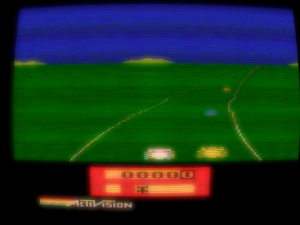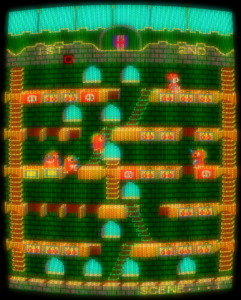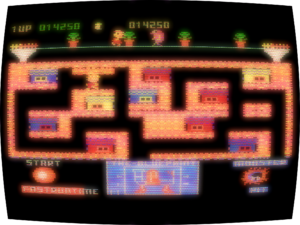 The Game: The war between the humans and the spacefaring enemy Dracons isn’t going well, and you’ve enlisted to join the fight. In the cockpit of your space fighter, you toggle between your flight computer (where you can find and set a course for Dracon attack groups on the map, or helpful starbases where you can replenish and repair your ship) and the direct view ahead when you engage in combat. The Dracons throw a lot of firepower at you, but your own torpedoes have a longer “reach” than their ammo. Your ship can take a pounding in a firefight, gradually eliminating your shields, your targeting ability, and even your weapons. The game is over when you can’t withdraw for repairs and are destroyed by the Dracons. (Arcadia, 1982)
The Game: The war between the humans and the spacefaring enemy Dracons isn’t going well, and you’ve enlisted to join the fight. In the cockpit of your space fighter, you toggle between your flight computer (where you can find and set a course for Dracon attack groups on the map, or helpful starbases where you can replenish and repair your ship) and the direct view ahead when you engage in combat. The Dracons throw a lot of firepower at you, but your own torpedoes have a longer “reach” than their ammo. Your ship can take a pounding in a firefight, gradually eliminating your shields, your targeting ability, and even your weapons. The game is over when you can’t withdraw for repairs and are destroyed by the Dracons. (Arcadia, 1982)
The Game: In 1982, an assemblage of former Atari programmers, along with a few hand-picked rookie programmers, started their own third-party video game venture. To be in that market at that time, however, one had to make games for the Atari 2600, and the Arcadia programmers’ game concepts outstripped that machine’s software. Not to be slowed down by that minor problem, Arcadia introduced a new piece of hardware along with its first game. The Supercharger more than doubled the 2600’s RAM, and had the beneficial side effect of allowing Arcadia to avoid the costly practice of having cartridge casings made; instead of cartridges, the Supercharger loaded its enhanced games from cassette tape, usually in under 30 seconds.
 Arcadia’s first challenge, aside from getting the cartridge-buying public to spring for their cassette-based games, was an identity crisis. At around the same time as the Supercharger hit the stores, so did Emerson’s Arcadia 2001 console. To avoid potential legal clashes and consumer confusion, Arcadia – the company – quickly changed its name to Starpath. For a year, a good chunk of the cover artwork for Supercharger games was covered up by the Starpath logo, followed by “formerly Arcadia”. Starpath stuck it out through the crash, but like so many software vendors leaning on the Atari 2600 for a living, they were in the wrong place at the wrong time, and the company was eventually sold to Epyx.
Arcadia’s first challenge, aside from getting the cartridge-buying public to spring for their cassette-based games, was an identity crisis. At around the same time as the Supercharger hit the stores, so did Emerson’s Arcadia 2001 console. To avoid potential legal clashes and consumer confusion, Arcadia – the company – quickly changed its name to Starpath. For a year, a good chunk of the cover artwork for Supercharger games was covered up by the Starpath logo, followed by “formerly Arcadia”. Starpath stuck it out through the crash, but like so many software vendors leaning on the Atari 2600 for a living, they were in the wrong place at the wrong time, and the company was eventually sold to Epyx.
 Packed in with the Supercharger was Phaser Patrol, a game which was essentially the same as Star Raiders, though in game mechanics only. Audiovisually, Phaser Patrol was the clear winner, and arguably it also won the day by simplifying Star Raiders‘ convoluted control scheme to bare essentials. (Star Raiders required, and was included with, a 12-key keypad controller, which very few later releases ever used.) In Phaser Patrol, one still had to use an unusual extra control – using the left difficulty switch to toggle back and forth between the cockpit view and the flight computer – but nothing on the level of the Star Raiders keypad.
Packed in with the Supercharger was Phaser Patrol, a game which was essentially the same as Star Raiders, though in game mechanics only. Audiovisually, Phaser Patrol was the clear winner, and arguably it also won the day by simplifying Star Raiders‘ convoluted control scheme to bare essentials. (Star Raiders required, and was included with, a 12-key keypad controller, which very few later releases ever used.) In Phaser Patrol, one still had to use an unusual extra control – using the left difficulty switch to toggle back and forth between the cockpit view and the flight computer – but nothing on the level of the Star Raiders keypad.
 Both games were equally tough and had a fairly steep learning curve if your space combat duty only went as far as Space Invaders experience, but Phaser Patrol was completely engrossing. It was a great choice to introduce gamers to the
Both games were equally tough and had a fairly steep learning curve if your space combat duty only went as far as Space Invaders experience, but Phaser Patrol was completely engrossing. It was a great choice to introduce gamers to the  Supercharger, though Arcadia’s (or Starpath’s) new add-on box would eventually suffer from too many games along these lines: great looking, but clearly just variations on familiar themes. But on its own, Phaser Patrol was quite impressive.
Supercharger, though Arcadia’s (or Starpath’s) new add-on box would eventually suffer from too many games along these lines: great looking, but clearly just variations on familiar themes. But on its own, Phaser Patrol was quite impressive.



